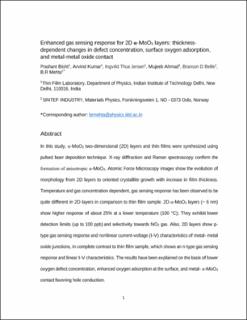| dc.contributor.author | Bisht, Prashant | |
| dc.contributor.author | Kumar, Arvind | |
| dc.contributor.author | Jensen, Ingvild Julie Thue | |
| dc.contributor.author | Ahmad, Mujeeb | |
| dc.contributor.author | Belle, Branson | |
| dc.contributor.author | Mehta, Bodh | |
| dc.date.accessioned | 2021-11-15T08:23:55Z | |
| dc.date.available | 2021-11-15T08:23:55Z | |
| dc.date.created | 2021-04-20T18:35:38Z | |
| dc.date.issued | 2021 | |
| dc.identifier.citation | Sensors and actuators. B, Chemical. 2021, 341 . | en_US |
| dc.identifier.issn | 0925-4005 | |
| dc.identifier.uri | https://hdl.handle.net/11250/2829509 | |
| dc.description.abstract | In this study, α-MoO3 two-dimensional (2D) layers and thin films were synthesized using pulsed laser deposition technique. X-ray diffraction and Raman spectroscopy confirm the formation of anisotropic α-MoO3. Atomic Force Microscopy images show the evolution of morphology from 2D layers to oriented crystallite growth with increase in film thickness. Temperature and gas concentration dependent, gas sensing response has been observed to be quite different in 2D layers in comparison to thin film sample. 2D α-MoO3 layers (∼ 6 nm) show higher response of about 25 % at a lower temperature (100 °C); They exhibit lower detection limits (up to 100 ppb) and selectivity towards NO2 gas. Also, 2D layers show p-type gas sensing response and nonlinear current-voltage (I–V) characteristics of metal- metal oxide junctions, in complete contrast to thin film sample, which shows an n-type gas sensing response and linear I–V characteristics. The results have been explained on the basis of lower oxygen defect concentration, enhanced oxygen adsorption at the surface, and metal- α-MoO3 contact favoring hole conduction. | en_US |
| dc.language.iso | eng | en_US |
| dc.publisher | Elsevier | en_US |
| dc.rights | Attribution-NonCommercial-NoDerivatives 4.0 Internasjonal | * |
| dc.rights.uri | http://creativecommons.org/licenses/by-nc-nd/4.0/deed.no | * |
| dc.title | Enhanced gas sensing response for 2D α-MoO3 layers: thickness-dependent changes in defect concentration, surface oxygen adsorption, and metal-metal oxide contact | en_US |
| dc.type | Peer reviewed | en_US |
| dc.type | Journal article | en_US |
| dc.description.version | acceptedVersion | en_US |
| dc.rights.holder | This is the authors’ accepted and refereed manuscript to the article. This manuscript version is made available under the CC-BY-NC-ND 4.0 license. VoR is available here: https://doi.org/10.1016/j.snb.2021.129953. AAM open access from April 20 2023 | en_US |
| dc.source.pagenumber | 11 | en_US |
| dc.source.volume | 341 | en_US |
| dc.source.journal | Sensors and actuators. B, Chemical | en_US |
| dc.identifier.doi | 10.1016/j.snb.2021.129953 | |
| dc.identifier.cristin | 1905390 | |
| dc.relation.project | Norges forskningsråd: 280788 | en_US |
| dc.source.articlenumber | 129953 | en_US |
| cristin.ispublished | true | |
| cristin.fulltext | postprint | |
| cristin.qualitycode | 1 | |

